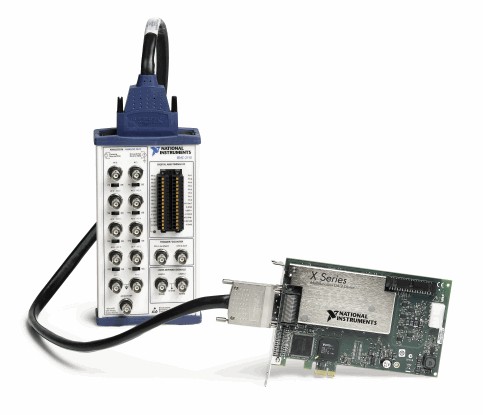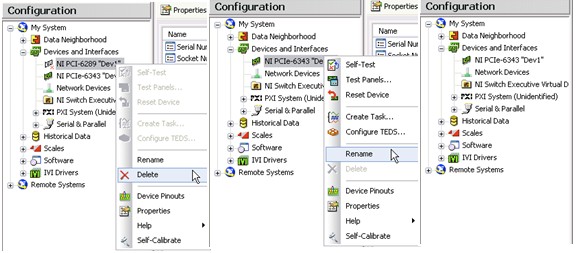NI X Series 63xx Upgrade Guide
NI X Series 63xx devices for USB, PCI Express, and PXI Express introduce significant improvements in onboard timing and triggering and include optimizations for use with multicore PCs. A desktop PC that you have purchased in the last few years likely has at least one PCI Express slot.
See What Is NI X Series? for more comprehensive information about X Series features and benefits. Upgrading your data acquisition system to use X Series devices is easy and, in most cases, these devices work seamlessly with previously developed applications and test fixtures. However, because of the enhanced 100 MHz timebase and other feature improvements, you may need to make slight software modifications in some cases.
Hardware Upgrade Considerations
PCI Express and PXI Express X Series devices use the same 68-pin VHDCI connector as most NI data acquisition devices. You can use the same cables and accessories, including the BNC-2120, SCB-68, and SCXI, for high-channel-count signal conditioning.
Figure 1. PCI Express and PXI Express X Series devices use a VHDCI connector, so you can reuse your existing NI M Series cables and accessories.
In addition, all USB, PCI Express, and PXI Express X Series devices use a pinout that is designed for backward compatibility with NI M Series and S Series data acquisition devices.
Software Upgrade Considerations
PCI Express and PXI Express X Series devices require NI-DAQmx 9.0 or later, and USB X Series devices require NI-DAQmx 9.2 or later.
You need to refer to your X Series device with the proper device name in the NI-DAQmx function calls within your application. You can find your device name inside the NI Measurement & Automation Explorer (MAX) configuration utility. If you are replacing an M Series device with an X Series device, you can choose from two ways to update your application:
- In MAX, replace the X Series device name with the previous M Series device name. This ensures that duplicate names are not used. See a screenshot from MAX in Figure 2.
Figure 2. You can change the device name in MAX by right-clicking on the device and selecting “Rename.”
- In the application you are updating, replace all references to the M Series device name with the new X Series device name.
Refer to Table 1 to see X Series devices with the channel counts and sampling rates most similar to M Series devices.
X Series Upgrade and Specification Table
M Series Device | X Series Device | X Series AI/AO/DIO Channels | X Series Max AI Sample Rate (Single Channel) |
|---|
X Series Upgrade and Specification Table
M Series Device | X Series Device | X Series AI/AO/DIO Channels | X Series Max AI Sample Rate (Single Channel) |
|---|---|---|---|
| NI USB-6221 | NI USB-6341 | 16/2/24 | 500 kS/s |
| NI USB-6229 | NI USB-6343 | 32/4/48 | 500 kS/s |
| NI USB-6251 | NI USB-6351 | 16/2/24 | 1.25 MS/s |
| NI USB-6361 | 16/2/24 | 2 MS/s | |
| NI USB-6259 | NI USB-6353 | 32/4/48 | 1.25 MS/s |
| NI USB-6363 | 32/4/48 | 2 MS/s | |
| NI PCI-6220 | NI PCIe-6320 | 16/0/24 | 250 kS/s |
| NI PCI-6221 | NI PCIe-6321 | 16/2/24 | 250 kS/s |
| NI PCIe-6341 | 16/2/24 | 500 kS/s | |
| NI PCIe-6323 | 32/4/48 | 250 kS/s | |
| NI PCIe-6343 | 32/4/48 | 500 kS/s | |
| NI PCIe-6351 | 16/2/24 | 1.25 MS/s | |
| NI PCIe-6361 | 16/2/24 | 2 MS/s | |
| NI PCIe-6353 | 32/4/48 | 1.25 MS/s | |
| NI PCIe-6363 | 32/4/48 | 2 MS/s | |
| NI PXI-6220, NI PXI-6221 | NI PXIe-6341 | 16/2/24 | 500 kS/s |
| NI PXI-6250, NI PXI-6251, NI PXIe-6251 | NI PXIe-6361 | 16/2/24 | 2 MS/s |
| NI PXI-6224, NI PXI-6229, NI PXI-6254, NI PXI-6259, NI PXIe-6259 | NI PXIe-6363 | 32/4/48 | 2 MS/s |
Table 1. X Series Devices Featuring Channel Counts and Sampling Rates Similar to M Series Devices
For more information about the behavior differences between X Series and M Series, see Major Differences Between E Series, M Series, and X Series DAQ Devices.

